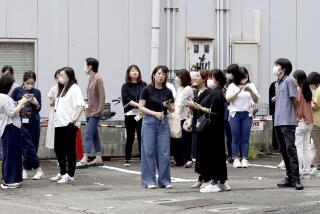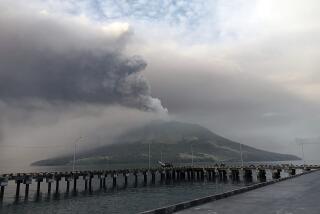Volcano erupts on southern Japanese island
- Share via
reporting from Tokyo — A volcano erupted on a small island in southern Japan on Friday, spewing black clouds of ash and rock and prompting authorities to tell residents to evacuate the island.
No injuries were reported after Mt. Shindake erupted about 10 a.m. local time, sending dense flows of rock and hot gases seaward, the Japan Meteorological Agency reported.
The agency raised the volcano alert level for Kuchinoerabu island, where Shindake is located, to five, the highest on its scale. Shindake also erupted in August last year -- the first time since 1980.
A military helicopter was sent to survey the island and assess damage. Chief government spokesman Yoshihide Suga told reporters in Tokyo that the Coast Guard had dispatched a ship to help evacuate residents.
Nobuaki Hayashi, a local village chief, said about 120 of the island’s 137 residents were gathered at a local evacuation facility.
“There was a really loud, ‘dong’ sound of an explosion, and then black smoke rose, darkening the sky,” he told the national broadcaster NHK. “It smelled of sulfur.”
Hayashi said a few people on the island were still unaccounted for. One person, who lives in an area that is generally off-limits, was to be evacuated by boat as he could not travel safely to the shelter by land.
“The skies here are blue, but smoke is still rising to the west,” he said.
Kuchinoerabu is 50 miles southwest of the main southern island of Kyushu. A heavily forested, mountainous island bordered mostly by rocky cliffs, it is a national park supported mainly by tourism and fishing.
Images from NHK showed the mountain shrouded in light gray ash as the clouds from the eruption cleared.
Kuchinoerabu usually can be reached only by a once-a-day ferry from Yakushima island, about seven miles to the east, which has an airport and a population of more than 13,000 people.
Japan has dozens of volcanoes and is frequently jolted by earthquakes.
In March 2011, a magnitude 9 earthquake rocked northeastern Japan, triggering a tsunami that killed more than 18,500 people and ravaged much of the northern Pacific coast.
Authorities recently closed part of a popular hot springs about 50 miles from Tokyo because of fears Mt. Hakone, which sits to the southeast of Mt. Fuji, might erupt.
The eruption last September of another volcano, Mt. Ontake in central Japan, killed 57 people.
Setsuya Nakada, a professor at Tokyo University, told NHK that the eruption on Kuchinoerabu was stronger than Mt. Ontake’s.
More to Read
Sign up for Essential California
The most important California stories and recommendations in your inbox every morning.
You may occasionally receive promotional content from the Los Angeles Times.










